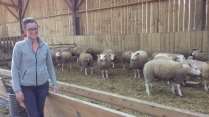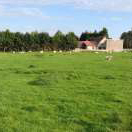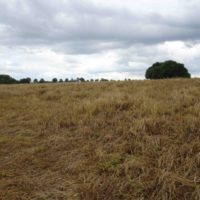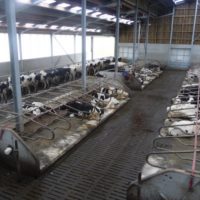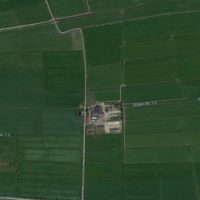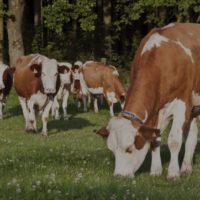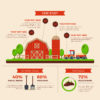Description
Background
The farm, located in the department of Eure, consists of:
- a herd of 350 sheep and lambs of the Texel breed
- an all-grass system with 47 ha of unfertilized natural grasslands
- 1.5 LU
The environment consists of:
- a good quality soil type
- a temperate oceanic climate marked in 2018 by a significant summer drought but suitable to grass harvesting in the spring
With regard to grassland management, the criteria are as follows:
- natural grasslands composed of multi-species mixtures, with 2 main types encountered: White Clover-Red Clover-Birdsfoot-Trefoil and Rye-grass-Brome grass-Fescue-Cocksfoot-Bluegrass-Creeping soft grass
- 100% of grasslands are grazed (73% of which are grazed and mowed)
- type of forage conservation: hay
Two batches of ewes (250 in total) are conducted in dynamic rotational grazing since spring 2017.
The young ewes are conducted in rotational grazing with complementation.
The main reason for this choice of system is the desire to reduce food costs, thanks to quality grazing, and also to reduce the parasite pressure on the farm.
The technical mastery that innovation implies is one of the great sources of motivation of the breeder.
Innovation is also part of the search for a better use of grass by lambs.
Detailed description
Recent implementation of dynamic rotational grazing (in 2017) in sheepmeat system. The ewes are grazing all year round, they only return a few days in sheepfold for lambing.
The breeder has set up dynamic rotational grazing on the 2 main areas of the farm:
- Area 1: 13 ha divided into 13 plots for 100 ewes with twin lambs (1 day / plot)
- Area 2: 13,5 ha divided into 13 plots (7 plots in 2017) for 150 ewes with single and twin lambs (3 days / plot)
1st batch of ewes on area 2:
- lambing in February
- the lambs from this lot are kept for the renewal of the herd (100 / year)
- dynamic rotational grazing from March 1st to June 1st, 120 days
- 3 days / plot on average
- 1 month into the building
- Weaning on June 1st and then on grass (ewes and lambs separated) from June 8th to September 1st
2nd batch of ewes on area 1:
- lambing in March (April-May in 2017)
- butcher lambs
- dynamic rotational grazing from May 1st to July 15th, 75 days
- 1 day / plot on average
- 1 month ½ into the building
- Weaning on July 15th and then back on grass (ewes and lambs separated) from July 20th to September 1st
The lambing period of the 2nd batch of ewes was brought forward one month in 2018 to meet the
objective of optimum use of grass by the lambs at the time of grazing.
Results
Dynamic rotational grazing reduces the parasite pressure on the farm and therefore the use of dewormers.
This grazing management allows to have homogeneous lambs with a satisfactory weaning weight.
This technique makes it possible to have a regular contact with the animals and thus to obtain a better follow-up thanks to a better anticipation.
The health status of the grasslands is also improved in terms of weed control such as common thistle.
In 2017, the technical and economic criteria did not improve compared to 2016, except for veterinary fees which decreased by € 2 per ewe. This finding is not related to the implementation of dynamic rotational grazing on the farm but to a poor reproduction period in November 2016. This has strongly impacted the prolificity of ewes and therefore the productivity of the herd. The prolificity rate has indeed decreased by 15% in 2017 compared to 2016. These criteria will
probably improve during a normal year. That said, the year 2018 has not been one again!
Adoption criteria
The success of this innovation stems from the breeder’s desire to improve the use of grass.
It implies having a good technical mastery in the grasslands management, especially in the organization and layout of the plot (size of paddocks, access roads, water points …).
Advantage of having 2 big areas grouped together on the farm.
The breeder considers herself to be a breeder of sheep and a producer of grass.
Future prospects
The farmer would like to extend this innovation to all sheep on the farm. About 50 young ewes and 50 ewes are still on “classical” rotational grazing, for reasons of surveillance and nutritional supplementation. The goal would be for all animals to be led in dynamic rotational grazing.
Thus, it is necessary to rethink the organization and layout of plots that are not in DRG today, and perhaps even to review the size and the cut of the areas that are already there.
This requires an investment in working time and equipment (water points, etc.) to set it up.
This innovation can be disseminated by:
- grazing promotion events, such as “Prairiales” in Normandie
- specialized websites
- exchange forum
The threats or fears that can slow the development of this innovation are:
- the increase of herds which limits this technique when the herd is too large
- global warming and especially extreme periods: intense rains that can encourage the animals trampling or the periods of hot weather, such as this summer 2018, which can come to stop the restart of grass growth.


